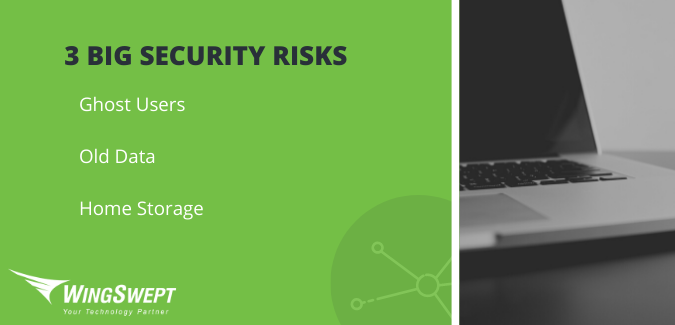As a business leader, it’s challenging to distinguish between significant security threats and those that are less likely to affect your organization. This is especially true nowadays, with frequent reminders about cybersecurity’s importance. While we emphasize cybersecurity’s significance and our role in educating small to mid-sized business leaders, we acknowledge the weariness caused by constant alarming threats.

To assist you in navigating the complexity, we’ve pointed out 3 Big Cybersecurity Risks that cyber attacks focus on. By addressing these weak points, you’ll greatly enhance your defense strategy.
What Is a Ghost User? Are They the Weakest Link in Your Cybersecurity?
“Ghost Users” are active accounts for former employees on the corporate network despite their departure from the company. Criminals look for ghost users’ login information to either encrypt or steal company data. They do this because they expect their unusual online activity to go unnoticed, as these accounts are often not the main ones used by anyone.
The tricky aspect of the ghost user situation is that they aren’t always inactive, nor are they accidentally left lingering. When high-level employees depart, they sometimes intentionally keep their accounts active. This practice arises from the use of these credentials to access critical computers or software tools.
How Keeping Old Data Can Hurt Your Business
Each piece of information your company retains increases its risk. Some of that risk is unavoidable, you need data to run your business.
But there’s also plenty of data risk that’s not worth carrying. Consider former customers’ expired credit card numbers.
You’ll never charge that card again, but failing to secure and prevent its leakage or theft could expose you to lawsuits. If someone successfully exploits that expired number to steal current financial information, it could also disrupt a former customer’s pleasant month (or year).
Three Places You May Be Storing Sensitive Data without Knowing It
This became an especially important factor when the pandemic hit in March 2020 and employers sent their employees home in droves to work from home for the first time. Confusion reigned on both sides and many of us were preoccupied with what was happening around us and less focused on keeping data secure.
As a result, businesses began storing data on various devices and in locations distinct from previous records. We were all doing the best we could, but now may be the time to audit those practices.
Navigating Threats and Safeguarding Assets
Navigating the intricate landscape of cybersecurity challenges requires continuous vigilance and informed decision-making. The dilemma of discerning between imminent security threats and remote possibilities remains a persistent concern for business leaders, compounded by the relentless reminders of cybersecurity’s paramount importance. Amid the potential fatigue from such alarms, our focus on educating and empowering small to mid-sized business leaders remains steadfast. To provide tangible assistance, we have spotlighted three pivotal vulnerability areas that cyber attacks often exploit.
By addressing these areas, namely the lurking risks posed by “Ghost Users,” the potential hazards of retaining unnecessary data, and the inadvertent dispersion of sensitive information in the era of remote work, organizations can substantially bolster their defensive strategies and fortify their overall cybersecurity stance. In this dynamic and ever-evolving digital landscape, a proactive approach to risk management and data protection is the linchpin to sustaining business resilience and safeguarding invaluable assets.
If you have additional questions about data security or would like to strengthen your organization’s defense against cyber attacks, please call us at 919-460-7011 or email us at Team_WingSwept@WingSwept.com.
